Previously, in The Pavilion of New Times, Paul encountered the work and ideas of the great French architect, Le Corbusier at the 1937 Paris International Exposition. A few months later he is given the chance to apprentice to the master…
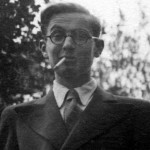
In London Pál worked happily for Moholy-Nagy for a year, (as described in Beauty, Art, and The Shape of Things To Come). Then Moholy received an offer to move to Chicago to start the new Bauhaus American School of Design. He generously offered to take Pál with him. It was an incredible opportunity but my father said “no.” When I pressed him he said merrily: “Who the hell wanted to go to an uncivilized country like America? And Chicago? I had this vision of a gangster city. I felt so sorry for them!”
Graciously Moholy-Nagy then offered Pál a letter of recommendation to Le Corbusier. What aspiring young architect could resist a chance to sit and learn at Pope Corbu’s feet? Well, my father, for one.
“I said to him [Moholy] I didn’t want to go to work there because I heard that he [Le Corbusier] would probably never even talk to me. And then Moholy said something very sensible. He said, ‘Doesn’t matter. You go there. Maybe he will never talk to you but you will be there in that atmosphere and you will see other people doing things and just breathe in the air and it will be good for you.’”
Because Pál seemed programmed to do the opposite of anything that was proposed he did not immediately act on this advice. Instead he found another job in London, making good money. He and Madeleine began to talk about her quitting her job and joining him.

This was in February and March of 1938. On March 11th Hitler annexed Austria. In Vienna, the city where little Pali had gone to have is hair died blond, nightmarish scenes unfolded. Tens of thousands of Jews tried to flee from Austria and Germany. Anticipating a flood, England tightened restrictions on immigration and moved to deport illegals already within their borders. In London, British immigration authorities finally caught up with Pál . His visa had expired. He was given forty-eight hours to leave the country. He went to Paris and Le Corbusier.
Most young architects who worked for Le Corbusier were not paid. They came from all over the world for the privilege of sitting at the drafting tables in the long narrow room of the atelier at 35, rue Sevres. My father insists that some actually paid Le Corbusier for the privilege of being his disciple. But thanks to Moholy-Nagy’s introduction he was invited to breath the air in God’s office for free.
He moved to Paris in early April 1938 and found a room at a flophouse called Hotel de Colonies at 20, rue Oudinot. It was a fifteen-minute walk through the Latin Quarter to Le Corbusier’s office, located in a disused wing of a Jesuit monastery, adjacent to St. Ignatius Church.
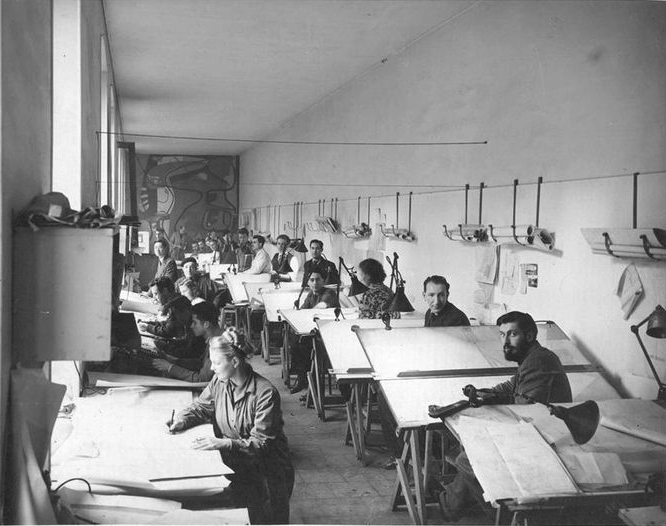
To get to the second floor atelier one had to endure the scrutiny of a suspicious concierge and climb a dark staircase. At the head of the staircase one encountered an enigmatic symbol, a modernist’s glyph. Red hand-painted letters on a hand-shaped blue metal plaque read Atelier Le Corbusier. A door opened onto a long, narrow, high ceilinged room flooded with light from windows that overlooked the monastery courtyard. The space was only wide enough for a single row of a dozen drafting tables, each with it’s own black, adjustable lamp clamped to the work surface. There were trays of fat pencils, pens, and drafting tools. A large stove was situated in the middle of the room. Every horizontal surface was covered with plans and drawings. More drawings were pinned to the walls or rolled up and held in special metal cradles.
Le Corbusier was not an easy man to work for. He was quick to anger and could get nasty, in a sarcastic way, when someone misunderstood his instructions or failed to grasp a concept. He kept to a rigid schedule, working at home in the mornings and arriving at the atelier at 2:00 each day. Jerzy Soltan, a young Polish architect who worked there for four years, wrote that:
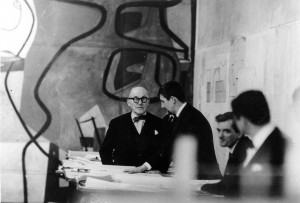
“Every day at 2:00, just before his appearance, a cloud of panic hovered over the atelier… he brought from home new ideas, new sketches, new notes. They were not easy to decipher. Corbusier had the ability to communicate clearly… but he also had his own sense of how much information to give, where to stop. The sketches at some point became fuzzy… a sign that they represented more his digging into the subconscious, his guessing, than a finished proposal. He would pass them on to us with a mischievous smile… The role of the team was then to interpret, clarify, and present the concept for his scrutiny in a precise graphic form, sometimes as a model. The more intuitive his thoughts, the more difficult it became to decipher his notes.”
The short period from April to August 1938, during which Pál worked at the atelier did not coincide with the production of any of Le Corbusier’s great works. It was a bleak time for modernism. Le Corbusier, Moholy-Nagy, and Gropius were under attack in the fascist’s propaganda war and most of the work at rue de Sevres consisted of proposals rather than paid commissions. Two of Le Corbusier projects that Paul worked on were a fifty-story skyscraper planned for Algiers and a city planning project for Boulogne-sur-Seine, a western suburb of Paris, which involved the re-configuration of municipal structures and roadways converging at a bridge over the Seine river.
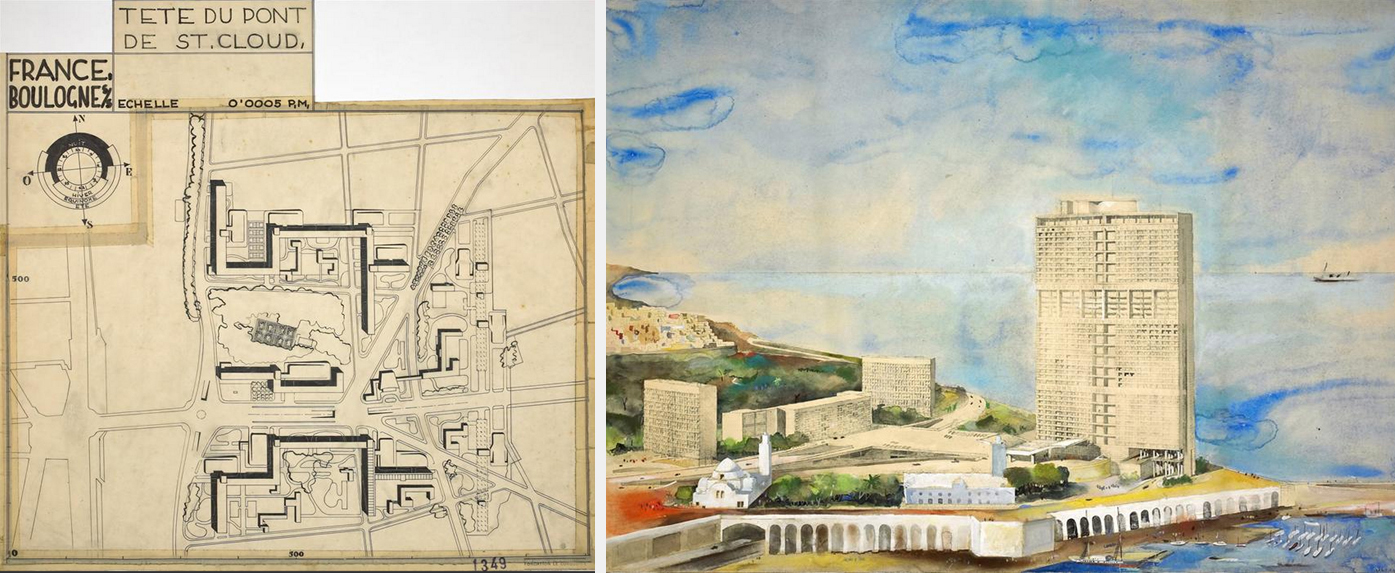
At the same time the atelier was occupied with the design of a model house to be installed in London’s Ideal Home annual exhibition and a children’s board game to be marketed in Europe and the United States. The game, called La Ville Radieuse (The Radiant City) was a utopian monopoly. It was based on Corbusier’s vision for a city of the future that would re-unite man in a well-ordered environment. The city drew upon the shape of the human body, with a head, spine, arms and legs; so that humans would be living in a city shaped in their own image. The city included high-rise housing blocks perched on columns or pilotis, with abundant green space, and pedestrian paths.
Le Corbusier never saw the realization of his vision for a utopian city but perhaps one day children would roll their dice and move their markers on its colorful map and become inspired.
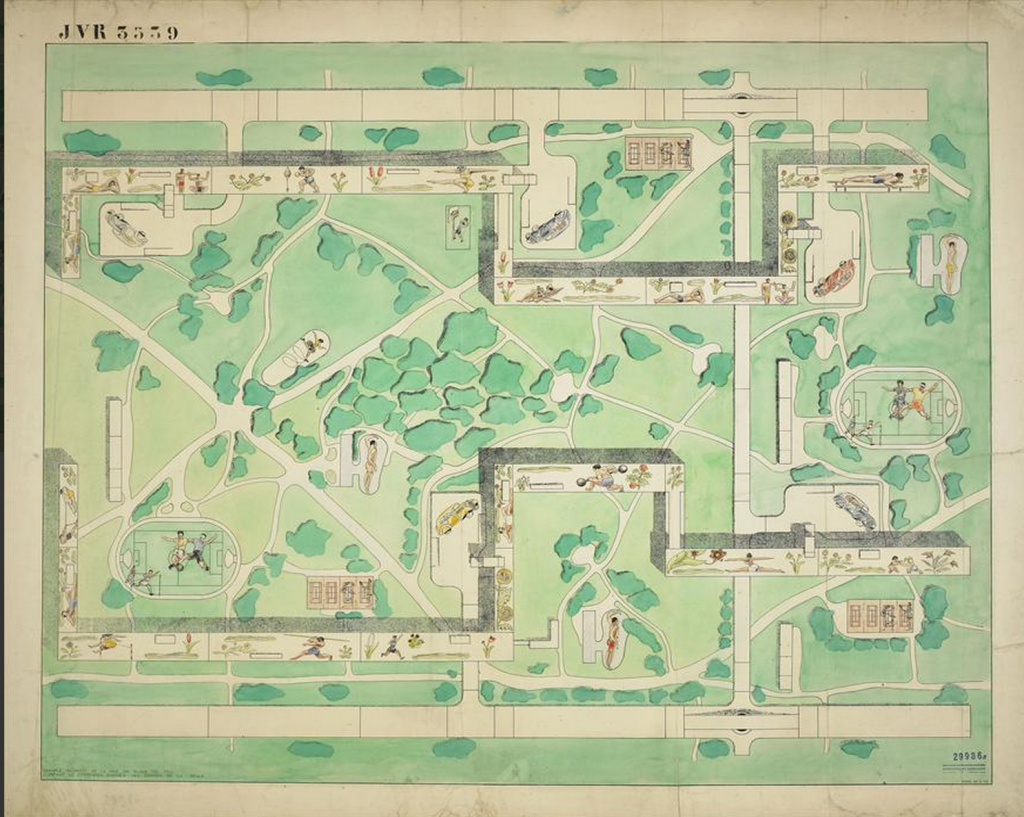
As we shall see Pal did not unquestioningly accept Le Corbusier’s utopian notions or his simplistic, functionalist slogans (“a house is a machine for living in”) but it is clear that something of the man rubbed off on him.
As a young man Le Corbusier was deeply influenced by Friedrich Nietzsche’s existential novel, Thus Spoke Zarathustra. In the book a prophet descends from his mountain cave to foretell the coming of the superman (Ubermensch), a being free from all the prejudices and moralities of human society; a being who creates his own values and purpose.

This superman is a rugged loner. He must destroy conventional order and wisdom before he can realize his own revolutionary genius. He may be an enlightened captain of industry using his wealth and power to the betterment of mankind. He may be a scientific prodigy or even a modernist architect, who has made it his task to redesign the cities of the world.
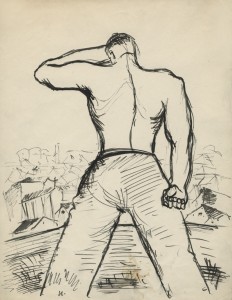
The superman’s struggle is often symbolized as climbing a mountain.
Later developments in Paul’s life, decisions he took, pronouncements he made suggest that Nietzsche’s archetype strongly resonated with him. I am reminded of one of his pencil drawings from this period. It is of a male colossus, legs astride surveying the rooftops of a vast city.
© COPYRIGHT, 2015 MOIRA PRODUCTIONS. ALL RIGHTS RESERVED